  



                                                    |

Overview
Edinburgh Case Study
Madrid Case Study
Oslo Case Study
Vienna Case Study
Case Study Comparison
| Overview
The assessment of cities’ needs in PROSPECTS was based
on detailed collaboration with six case study cities, with
whom the project discussed decision-making needs, and for
whom it conducted a series of model-based analyses to test
the principles set out in Sections
7 to 14. These six, Edinburgh,
Helsinki, Madrid, Oslo, Stockholm and Vienna, all represent
good practice in policy formulation and implementation, though
none follows in full the approaches which we recommend in
this Guidebook. They are inevitably not representative of
all types of European city. In practice they are all relatively
large, with populations in the city region ranging from 0.7M
to 5.3M. They are also all capital cities, and thus attract
greater attention than provincial cities of the same size.
To help overcome this, PROSPECTS also conducted a questionnaire
survey of decision-making contexts and needs in a further
54 cities from 17 countries, as highlighted in the map. Of
the 54, 14 had populations of 30,000 to 100,000, 20 between
100,000 and 250,000, and 20 of over 250,000. They included
25 from northern and central Europe, 22 from southern Europe,
and 7 from Newly Associated States in eastern Europe. The
survey covered city characteristics, responsibilities, influences
and participation; types of decision-making approach; objectives,
indicators, targets and time horizons; past trends and future
scenarios; policy instruments considered; and barriers to
implementation. We have presented some of the results from
this survey in Sections 3,
4 and 10;
the full results, including comparisons between cities of
different size and in different regions, are available in
Deliverable 1 of PROSPECTS, listed in Section
18.
In this section we present four of these full case studies.
As noted above, none of them represents fully the approach
which we have advocated in this guidebook. As a result there
are differences between them, both in the problems to be tackled
and in the approaches which they have adopted. This is helpful
in enabling both strengths and weaknesses in their approaches
to be illustrated.
Case study structure
In the following eight pages, we summarise each of the four
case studies in terms of the principal themes of this guidebook,
grouped as shown. In the latter two sections, we have only
commented where the cities have adopted particularly interesting
approaches. In the last two pages we have compared the four
against each of these themes to identify examples of good
practice and key messages for others using this Guidebook.
The four case studies
Edinburgh, the capital of Scotland, has a population of 450,000,
but serves as regional centre for some 700,000 people. It
has developed around the historic Old Town and castle, which
was an easily fortified volcanic plug just south of the Firth
of Forth. The urban area is now developed up to the coast
in the north, and to the next range of hills to the south.
The Old Town and eighteenth century New Town are now a World
Heritage Site, and Edinburgh has an active tourism and cultural
industry, as well as being the legal and financial centre
of Scotland.
Madrid is one of the 17 Autonomous Regions in Spain, with
a slowly growing population (5.4 million inhabitants in 2001,
and a yearly growth rate of only 0.5% since 1986) in an area
of 8,028 km2. The population is distributed unevenly among
Madrid City (2.9 millions and 4,727.7 inh/km2), the metropolitan
ring (2.1 millions and 471 inh/km2) and the mainly rural rest
of the region. Sprawl trends, with the central core losing
population to metropolitan municipalities, have increased
recently.
Oslo, the capital of Norway, has a population of 500 000,
with 470 000 more in the surrounding Akershus county. Two
thirds of the city’s area is woodlands, and it has long
been a policy not to expand into this green belt. Once an
industrial centre, Oslo is now predominantly a service city.
Oslo was quite successful up to the 1980s in relocating the
inner city population to new residential areas, providing
these with metro lines and other amenities from the start,
and regenerating the inner city. However, long term trends
towards relocating in Akershus outside the green belt are
now generating urban sprawl. In transport, the most important
experience has been the financing of new road construction
by way of a toll ring.
Vienna is situated in eastern Austria, not far from the borders
with Hungary, Slovakia and the Czech Republic. The capital
of Austria, it has a population of 1.6 million (city area:
415 km²). It is by far the largest city of the country,
with 20% of the population of Austria. The so-called “Urban
Region Vienna” covers an area with a radius of 40 to
50 km around Vienna and has a total population of 2.2 million.
The development of the population, settlement and employment
structures in the Vienna region has led to urban sprawl and
in particular to a sharp increase in car traffic.

|
|
| |
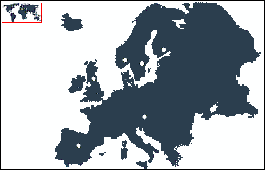 |
| |
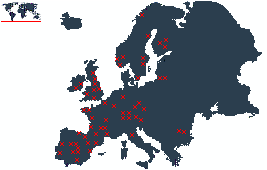 |
| |
Case study summary
• Decision-making
context (Section 3 )
• Approach to decision-making and participation
(Sections 4, 5)
• Objectives, indicators, targets and problems (Sections
7 , 8)
•
Instruments, barriers and strategies (Sections
9 , 10, 11)
• Prediction, appraisal and optimisation (Sections
12 , 13, 14)
• Implementation and monitoring (Section
15) |
|
| |
 |
| |
 |
| |
 |
| |
 |
|
|
| |
| Case Study
1 – Edinburgh Decision-making
context
Edinburgh has experienced major changes in responsibilities
for transport and land use. Regional and District Councils
were abolished in Scotland in 1996 and replaced by unitary
authorities. Power for many policies, including transport,
was devolved from London to the Scottish Parliament in 1998.
As a result, the City of Edinburgh Council is now responsible
for transport policy within policies laid down by the Scottish
Executive. The Executive follows national policies closely,
but with subtle differences in implementation. In 1996 the
Scottish Executive set up the Local Transport Strategy (LTS)
policy documents for councils to produce for their area in
the context of the strategic Structure Plan policies. The
City of Edinburgh Council is responsible for all roads within
the city, but not for the trunk roads and motorways which
approach it. Bus services were deregulated in 1986 and many
are still run by Lothian Buses plc, who are still owned by
the Council and adjacent authorities. Rail services were privatised
in 1992, and all local services are now run by Scotrail.
Approach to decision-making and participation
Edinburgh reflects elements of all three approaches to decision-making.
It has made extensive use of plan-based studies to develop
its strategy. Having learnt from a period in the 1970s and
1980s in which sectional interests obstructed progress, it
consults widely in order to achieve consensus in its strategy.
It has had visionary leaders of its transport strategy, who
have been keen for Edinburgh to provide leadership nationally.
The 1991 transport study, which laid the foundations for the
strategy, involved workshops with representatives of all the
main interest groups to agree on the problems and objectives
and to identify possible solutions. The resulting strategy
included the possibility of road pricing, which was always
bound to be controversial, and the Council conducted three
consultations. The first, in 1999, obtained views from residents
and businesses on the choice between a low cost strategy without
demand management, a medium cost one with charges for employee
parking, and a high cost one financed by road pricing. The
second, in 2002, sought residents’ and firms’
views on three transport options including two road pricing
strategies. The third, in 2005, led to road pricing (“congestion
charging”) being rejected, following a city wide referendum.
This has led to a major reappraisal of the overall strategy.
Objectives, indicators, targets and problems
Edinburgh adopts an objective-led approach. It is expected
to work towards the government’s overall transport objectives
which cover the environment, safety, economic efficiency and
growth, and accessibility for all. These reflect most of the
objectives listed in Section
7 , with the possible exception of liveability and health
and some aspects of equity. They do not, however, place much
emphasis on longer term sustainability. Performance indicators
are largely those specified by government, and include both
intermediate outcome indicators of modal share and outcome
indicators for the environment and safety. Targets are set
for some of these, again largely reflecting government requirements.
Policy instruments, barriers and strategy formulation
The key elements of the New Transport Initiative are enhancements
to public transport infrastructure, improved management of
the road network and reallocation of road space. The possibility
of using road pricing to manage demand and generate revenue
was considered, but has since been rejected. A land use strategy
has been developed which complements these measures. The public
transport improvements include new guided bus and light rail
lines, reopening a disused rail line and introducing new rail
services, together with park and ride and extensive bus priority
schemes. Road network management measures include urban traffic
control, on-street parking control, pedestrian friendly streets
in the city centre, reallocation of other road space to buses
and cyclists, and traffic calming in residential areas. Other
innovative measures include experiments with car clubs and
car free neighbourhoods, company travel plans and awareness
campaigns.
The main institutional barrier is the integration of services,
ticketing and information by different service providers,
following deregulation. Finance for transport is severely
constrained, and road pricing has been developed as a major
source of financial support for the overall strategy. In spite
of extensive awareness raising and consultation road pricing
remains the most contentious element of the strategy, and
has now been rejected.
Prediction, appraisal and optimisation
Lothian Region commissioned a novel strategic transport model,
START, for the 1991 study. This was used to test some 70 possible
policy combinations, and enabled the key elements in the strategy
to be identified as the appropriate levels of infrastructure
provision, road space reduction, public transport fares, and
road pricing. The final strategy was based on these. Subsequently
a land use model, DELTA, was added, and the two have now been
upgraded to a new version, TRAM/DELTA, which enables the effects
of a transport and land use strategy to be tested over a twenty
year period. Appraisal methods are specified by government,
in Scottish Transport Appraisal Guidance (STAG), and include
a cost-benefit analysis, which covers travel and accident
costs, and a multi-criteria framework to highlight impacts
on the environment, accessibility and equity. Edinburgh provided
the test-bed for the optimisation methods described in Section
14. To date, however, the optimisation procedure has been
used primarily for research purposes.
Implementation
A key issue is how to manage the implementation of such a
complex strategy. A new body has been established: TIE (Transport
Initiative Edinburgh) Ltd, owned by the City Council but managed
by the private sector. The company is responsible for developing,
procuring and managing major projects; ensuring public acceptability;
procuring, implementing and operating the road pricing scheme;
and raising funds in other ways.
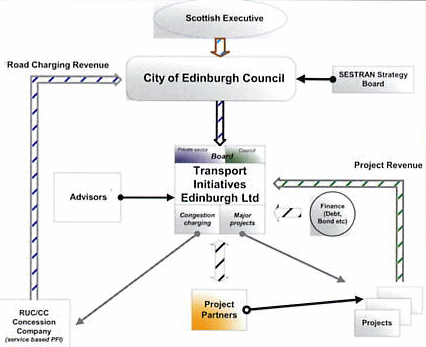

|
|
|
|
| |
Case
Study 2: Madrid
Decision-making context
The Madrid Regional Government has responsibility for regional
roads, while the main roads remain in the hands of the national
government and local roads with the municipalities. The Regional
Government is responsible for the approval of local urban
development plans (Planes Generales de Ordenación
Urbana) and for coordinating public transport services
in the region. It has promoted the Consorcio de Transportes
de Madrid, a public authority integrating most of the
public transport responsibilities previously in the hands
of the Regional and Local Governments. Almost all municipalities
have voluntarily joined the Consorcio and transferred
to it their responsibilities for public transport. The Consorcio
also runs the Metro system on behalf of the Region.
Approach to decision-making and participation
Although elements of all the three approaches to decision-making
are in operation, there has been a clear move from the “plan-led”
to the “vision-led” approach. Consensus among
institutions has been another key and continuing aspect, but
attempts to open up the process to other stakeholders have
lacked ambition and have yielded modest results. Regional
and local land use plans are required, by law, to hold public
hearings, prior to final approval. This is not the case for
many urban development and transport projects, and in particular
for the metro extensions built recently or in progress. More
participatory processes have been attempted, with mixed results.
While information provision is extensive, and formal and informal
consultations are made at various stages, there is no direct
influence of most groups in actual decision-making, or signs
of moving in that direction.
Objectives, indicators, targets and problems
The rapid movement of population to the suburbs in search
of better housing is leading to significant changes in transport
demand and land use patterns in the Madrid metropolitan area.
This has tended to dominate the Regional Government’s
objectives, which are to cope with this problem, while supporting
economic growth and seeking equity between the areas within
the region. Considerations of efficiency, environment and
safety are subsidiary to these, but still important in tackling
the problems of out-migration. There is not much emphasis
on long term sustainability and, indeed, the current trends
are producing more and longer journeys. The main indicators
and targets used, as discussed further below, relate to process
indicators of modal shares.
Policy instruments, barriers and strategy formulation
Transport policies have combined four key principles for many
years. An integrated public transport system has been developed,
covering fares, services and the administrative framework.
One of the key issues was the introduction of the PT Travelcard,
valid in the whole region. There has been an impressive investment
in transport infrastructure, including commuter rail services,
expansion of the metro system (with 120 km of new lines in
the last ten years), innovative infrastructure such as the
first HOV lane in Europe, and the development of park and
ride interchanges. Recently new tram projects have been passed
to connect suburbs with metro and commuter rail stations.
The quality of public transport has been enhanced, encouraging
and assisting undertakings to renew their fleets and introducing
more comfortable, less polluting vehicles. Information systems
are offered in the web, but information centres have not been
sufficiently developed.
Madrid City for its part is developing a strategy that reduces
car use in the centre: pedestrianisation, parking pricing,
car restrictions and segregated bus lanes.
Economic prosperity in the late 1990s has favoured a more
market-oriented approach to spatial planning: the
regional vision has been gradually replaced by ad hoc
planning, negotiated on a case-by-case basis between the Regional
Government (or the City of Madrid) and big developers. Transport
has emerged as one of the key elements in these negotiations,
with the public sector providing public transport infrastructure
to these newly developed areas, in some cases before urban
development actually occurs. The Regional Government’s
attempts to limit new urban development plans in the suburbs
have failed in the last few years, new urban development proposals
are generally approved by public authorities, with little
concern about their future impacts on the transport system.
Prediction, appraisal and optimisation
Both the Consorcio and Madrid Region use modelling
techniques based on EMME/2 to evaluate new infrastructure
for roads and public transport. The predictions are based
on a household mobility survey conducted every eight years
in the Region. All the plans and projects are appraised using
a cost-benefit analysis complemented by the appraisal of some
environmental and social effects. However, these techniques
are applied only to improve the design of strategies and projects
already decided by consensus among public bodies.
Implementation and monitoring
Monitoring is mainly focused on the effective implementation
of new facilities, and their co-ordination with the construction
of the new planned urban areas. Monitoring is also conducted
by the respective operators (parking lots, rail, metro, buses),
but there is not much interest in elaborating indicators to
make this information more useful for decision-makers and
the public. Modal split has received much attention as an
indicator of the effectiveness of transport policies in Madrid.
This is not surprising, as public transport patronage has
steadily increased since the Consorcio was created in 1986.
Today, Madrid is a leader in public transport share: public
transport covers 54% of all motorised trips (1997) in the
Region, and is dominant in the central city (66%) and in radial
trips (52%).
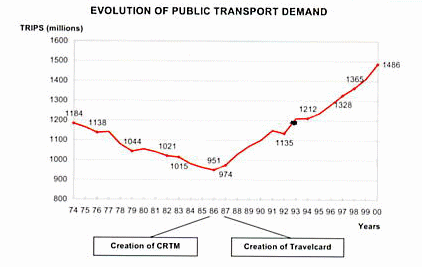

|
|
|
|
| |
Case Study
3 – Oslo
Decision-making context
The decision-making context in the Oslo region is very complex.
National authorities and their regional offices are in charge
of the trunk road system and the railway infrastructure and
get their funding from parliamentary budget decisions. The
national railway operator is in charge of local and intercity
railway traffic, and receives subsidies partly at the national
level and partly from Akershus county. There are two counties
in the region, Oslo and Akershus. The counties’ main
responsibilities are secondary health care, education, transport
(county roads and public transport) and strategic planning.
There are two major public transport providers, one for each
county. One of them procures all transport service production
from private firms, while the other (Oslo) produces tram and
metro services itself and provides bus services through its
subsidiary and another major firm. Land use regulation at
the detailed level is the responsibility of the third—municipal—level,
which in the case of Oslo is identical to the country level.
The municipalities are in charge of minor roads and streets.
Approach to decision-making and participation
The decision-making approach at the national level is plan-led.
Ten year national transport plans are rolled forward every
four years. Increasingly, they are also concerned with city
transport problems, and even try to include urban land use
policies. At the same time, the counties have their own strategic
plans. To the extent that elements of the local plans require
national funding, they will have to be adopted in the national
plan. The structure means that a system of consultation is
required to develop the plans. Planning based on local initiatives
and partial local financing through user charges has now become
the standard in Norwegian urban transport planning. A clear
statement of objectives and analysis of problems lead on to
consideration of the policy instruments needed to achieve
the objectives. However, since there are so many parties involved,
each with a need to get the plan through their elected bodies,
it is also vital to seek consensus. In the past, it proved
possible to reach a sufficient degree of consensus on strategic
road and public transport infrastructure packages: the Oslo
Package 1 of road infrastructure investment started in the
late 1980s and still underway, and the Oslo Package 2 of public
transport infrastructure initiated in 2000. Currently, a more
comprehensive package, Oslo package 3, is being devised along
the same lines. Issues of main road building, user charges
and equity have led to local political conflict on the package,
but consensus is expected to be reached soon. Participation
is sought through a system of hearings, meetings, information
leaflets and through media debate. Participation was especially
prominent in the regeneration of inner city residential areas.
Objectives, indicators and targets
At the highest level, the objective has been stated as follows:
the land use and transport system of Oslo and Akershus is
to be developed to promote socially efficient use of resources,
environmentally sound solutions, security in local communities
and neighbourhoods, traffic safety and a high level of accessibility.
Of the objectives of Section
7 , growth is given less priority in Oslo, while equity
issues are important even if not mentioned explicitly here.
For the national transport plan, a set of indicators has been
devised, although they do not seem to meet the decision-makers’
need for information and lack a clear link to objectives.
In the county plans many of the lower level objectives are
framed as targets.
Policy instruments, barriers and strategy formulation
Current plans are very much biased towards infrastructure
provision. As noted earlier, the most important Oslo experience
is the financing of a package of new road construction by
way of a toll ring. The toll ring was intended to raise money
without affecting traffic, and was rather successful in this
respect. However, legislation to allow road pricing and road
tolling for other purposes than financing infrastructure building
has since been enacted. At the municipal level, a charge on
studded tyres is levied and the toll ring extended to 2012
to finance urban regeneration in the harbour area. Seeing
that in spite of infrastructure provision, congestion and
air pollution are becoming severe problems, the coming Oslo
package 3 will have a broader scope. The strategy might consist
of concentrating development to public transport nodes; improving
public transport quality and implementing an area-wide common
policy on financing of public transport operations and on
fares; policies to promote walking and cycling and mitigate
environmental damage; and a car use policy that combines infrastructure
with traffic calming measures in a balanced package that takes
all effects into account. The implementation of a comprehensive
strategy will require a permanent coordinating group; agreement
on this constitutes a political barrier. The other main barrier
is finance. National policy has been unfavourable to Oslo
and the tax base has been eroded. To circumvent these barriers,
financing by user contributions has been developed.
Prediction, appraisal and optimisation
Transport models are used for large projects, and were used
to assess problems for the recent comprehensive plan. But
strategic plans have often consisted of a set of projects
that have been evaluated separately. LUTI modelling has only
been applied for research purposes. CBA (including accidents,
air pollution and noise) with an accompanying EIA have long
been the standard methods in appraisal. A common national
framework for this exists. Optimisation has only been used
for research purposes.

|
|
|
|
| |
| Case
Study 4 – Vienna Decision-making
context
Urban development and transport policy is the responsibility
of the Viennese city government and administration. Regional
development is coordinated by PGO (Planning Group for East-Region),
but this organisation has no legal power. Municipalities can
make their own decisions on land use within their respective
borders. Public transport responsibilities are divided between
the city of Vienna, which is responsible for inner-city PT
services (metro, tram, bus), and the national government,
which takes responsibility for railway and regional bus services.
The Transport-Association East-Region (Verkehrsverbund
Ost-Region: VOR) was established in 1984 in order to
establish an interconnecting network of transport services
with a unified fare structure. In July 2002, most federal
roads were turned over to local state government while major
motorways remain under the authority of national government.
Approach to decision-making and participation
The decision making of Vienna is more or less based on a mix
of approaches (Section 4).
However, the city mostly follows a plan based approach. The
fundamental objectives, policies and measures of urban and
transport planning were formulated in the Urban Development
Plan and the Traffic Concept (both published in 1994) and
updated recently in the Urban Development Plan 2005 (STEPS05).
These plans are to be updated every 10 years. Moreover, current
trends of urban development are analysed in Urban Development
Reports, the latest published in 2000. Visions for Vienna
were published in the Strategy Plan 2000 and the Masterplan
Transport 2003. In recent years, a consensus-based approach
has gained more and more importance, e.g. in the development
of the Masterplan Transport all citizens were able to participate.
This approach is very similar to that recommended in this
guidebook. The starting point was a participation process
in which the relevant stakeholders defined the overall objective.
Indicators to monitor the achievement of the defined objective
were defined.
Participation tools are used informally. The city administration
provides a lot of information for citizens and stakeholders
by means of publications, the Internet, exhibitions and a
citizens’ service office. Other elements of more active
participation are discussions and on-line chats about concepts
and projects of urban development. At the project level the
municipality uses a tool of citizens’ participation
(Burgerbeteiligungsverfahren) as a formal part of
the planning process. The main objectives are the transparency
of the planning process and to include as much as possible
public acceptance.
Objectives, indicators, targets and problems
The Traffic Concept includes objectives such as the reduction
of traffic impacts on the environment and health, an increase
of traffic safety and a reallocation of urban space for pedestrians
and cyclists. To achieve these objectives, a reduction in
urban sprawl, a reduction in traffic volume and an increase
in the mode shares for public transport, walking and cycling
are needed. Several indicators have been defined to monitor
the achievement of the objectives, such as modal split, traffic
safety (number of accidents, injuries and fatalities), noise
level, air pollutants and CO2. A target formulated in the
Traffic Concept 1994 is to reduce the modal share of private
car to 25% by 2010.
Policy instruments, barriers and strategy formulation
Vienna pursues a strategy of polycentric development to achieve
a reduction of urban sprawl and traffic volume. This strategy
includes elements of increasing the density of central districts,
urban expansion around sub-centres in the other districts
and axial development along regional railway lines. The Traffic
Concept provides a list of specific packages. Public transport
services are to be enhanced through an extension of the underground,
prioritisation of buses and trams and an improvement of marketing
and information. Walking and cycling are to be promoted through
an extension of pedestrian areas and bicycle ways. Car restraint
measures focus on parking space management within the inner
districts and traffic calming.
Barriers exist with respect to the axial development. Firstly,
there is a lack of co-ordination of the municipalities’
activities regarding land use within the Vienna region. Each
municipality pursues its own policies, and their aim is in
general to collect as much tax as possible. The main problem
is that no binding instruments are in place to support axial
development. The planning group PGO can only give recommendations.
Secondly, landowners and investors use their financial power
to overcome land use and transport policies, so that certain
projects are realised, which are not in accordance with the
planned and desired developments.
Prediction, appraisal and optimisation
The Viennese administration uses the multi-modal model VISUM/VISEM
as a formal transport modelling tool. VISUM is an information
and planning system for network analysis and forecasting.
VISEM is applied for the trip generation matrices based on
a travel demand model, which basically considers activities
and connects these with a mobility program. The urban planning
department has been using VISUM/VISEM for more than seven
years. During this time the model has been improved and the
transport network refined. It is used to model the whole urban
transport system as well as impacts of special projects. Currently
the model is being used to analyse impacts of urban extensions
in the north east of Vienna. There is no formal requirement
for appraisal.

|
|
|
|
| |
| Case
Study Comparison Decision-making context
None of the four cities has a simple structure for decision-making.
Edinburgh is notable for the number of changes in responsibility
which it has experienced in the last decade. It is also alone in
having little direct control over public transport fares and services.
However, it has the advantage, uniquely among the four, of having
direct responsibility for both transport and land use. Madrid has
an enviable degree of coordinated control over public transport,
which has been central to its strategy. Management of the road network
is dispersed, but does not appear to pose a serious problem. Its
main weakness is its inability to control the pattern of new development.
Oslo’s structure is the most complex, with a mix of responsibilities
at three tiers of government, and two separate counties responsible
for the conurbation. Vienna has the most integrated management of
its transport system but, once again, has its land use development
managed separately.
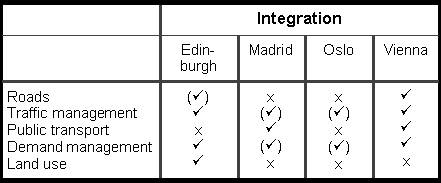
Approaches to decision-making
All four cities adopt a mix of vision-led, plan-led and consensus-led
approaches. Edinburgh combines all three, but places particular
emphasis on planning, followed by extensive consultation. Madrid’s
approach has changed over time, with a move away from planning towards
a vision-led emphasis. It seeks consensus among the agencies responsible,
but has not placed great emphasis on wider consultation. Oslo’s
approach is more strongly plan-led, with decisions based on ten
year plans rolled forward regularly. Increased emphasis is being
placed on consensus-building among the responsible agencies, and
wider consultation is a key element in its approach. Vienna has
a mixed approach, with less emphasis on analytical planning and
the strongest reliance on consensus-building and widespread participation.

Objectives, indicators, targets and problems
This aspect of the case studies reflects the greatest difference
in cultural approaches to strategy development. Edinburgh’s
approach is clearly objective-led, with objectives, indicators and
targets largely selected to reflect the expectations of government.
It includes most of the objectives proposed in this guidebook, with
the exception of inter-generational equity. Its targets are a mix
of outcome (safety, pollution) and intermediate outcome (modal shares).
Madrid does not have a clearly stated set of objectives, but is
principally concerned with economic growth and equity, and the problems
caused by traffic growth. Once again intergenerational equity is
not a concern. Its indicators relate principally to modal shares.
Oslo adopts virtually the full set of objectives proposed in this
Guidebook, with greater emphasis than the others on longer term
sustainability; conversely it is less concerned with economic growth.
It uses a range of indicators, but they are not well linked to the
objectives. Vienna has had an aim of reducing car use for several
years, but has only recently specified its objectives. Its principal
concerns are environment, health and safety, with some consideration
of longer term sustainability.
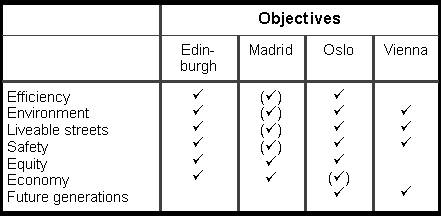
Policy instruments, barriers and strategy formulation
The balance of strategies differs between cities. All stress public
transport investment, and all have pursued innovative solutions.
Edinburgh emphasises management of road space and control of land
use. Madrid has introduced information systems and some road space
management, but places little emphasis on demand management or land
use controls. Oslo has invested in road building, but is now focusing
on public transport, walking and cycling, land use controls and
the potential wider use of road pricing. Vienna has a similar emphasis,
but uses parking controls and traffic calming as its main tools
for controlling car use. Finance is a barrier in all cities; so
is the mix of institutional responsibilities, which particularly
limit the ability to manage land use. Public acceptability is a
critical issue in Edinburgh and to a lesser extent in Oslo.
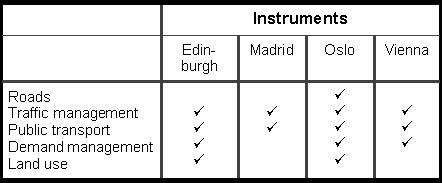
Prediction, appraisal and optimisation
All four cities use conventional four stage models to predict the
effects of alternative strategies, although Madrid only does so
to improve the design of already accepted proposals. Only Edinburgh
uses a land use-interaction model, and none as yet uses sketch planning
models or optimisation other than for research. Approaches to appraisal
differ markedly. Edinburgh and Oslo adopt a combination of cost-benefit
analysis and multi-criteria appraisal, as specified by their governments.
Madrid adopts a similar approach but only for enhancement of chosen
strategies. Vienna has no formal appraisal methods.
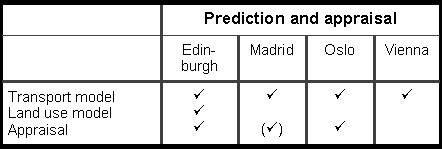
|
| |
Key messages
All four cities have been very successful and innovative in developing
their strategies. However, the above review has highlighted some
key messages for the future.
- Decision-making contexts are complex and difficult to change;
decision-making processes need to be designed to work within this
context
- However, failure to plan transport and land use together poses
serious threats for longer term sustainability, and needs to be
addressed by city governments
- Visions, plans and consensus are all important elements of decision-making;
in addition, the public are increasingly seeking active participation
- Some cities are less specific as to their objectives, focusing
instead on strategies to reduce car use. There is a danger that
this will lead to some key impacts of transport being overlooked
- Few cities are currently addressing long term sustainability.
While this is understandable, there is a need for an assessment
of longer term impacts
- Indicators and targets tend to reflect modal shares rather than
the impacts of transport on society, which could lead to the latter
being overlooked
- Public transport improvements are a dominant element of strategy,
but they alone will not control overall demand for travel or the
growth in car use. Greater emphasis is needed on land use and
demand management
- A greater emphasis on appraisal could help to ensure that the
chosen strategy is the most effective means of meeting the city’s
current and long term needs.
|
Key messages
•
Need to reflect complex decision-making
• Integration
of land use planning is crucial
• Visions, plans,
consensus, participation all key elements
• Objectives
need to be clearly stated
• Long term sustainability
must not be overlooked
• Outcome targets are
more useful than modal shares
• Land use and
demand management need greater emphasis
• Thorough
appraisal is needed to ensure effectiveness |
|

|




